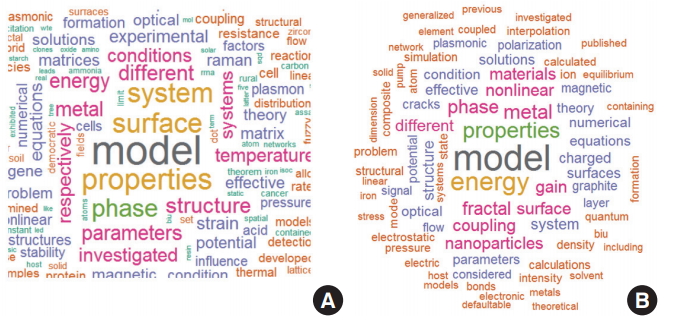Update: Bibliometric analysis of publications from North Korea indexed in the Web of Science Core Collection from 1978 to July 2018
Article information
Abstract
This study presents an update of a previous study, ‘Bibliometric analysis of publications from North Korea indexed in the Web of Science Core Collection from 1988 to 2016,’ which was published in Science Editing volume 4, issue 1. A re-analysis was performed because an incomplete search strategy was used in the original publication, and the present study analyzed the same bibliometric characteristics of publications from North Korea indexed in the Web of Science Core Collection from 1978 to 2018. The Web of Science Core Collection was searched by selecting ‘North Korea’ in the country field of the basic search results on July 31, 2018. A total of 533 articles were identified. There were no results from before 1978. China, Germany, and Australia were main countries of collaboration. Researchers from Kim Il Sung University produced the most articles. The main research fields were physics, mathematics, materials science, chemistry, and engineering. The funding agencies were mostly from China. The number of articles by North Korean authors only was 105, with the same main research fields. The results were almost the same as reported in the previous article, except for a much higher number of publications. The above results indicate that the North Korean government has asked researchers to publish their works in international journals; therefore, it has allowed them to access the internet. Based on the trends we identified, we anticipate that there will be a continuous increase in publications from North Korea in international journals indexed in the Web of Science Core Collection.
Introduction
In a previous study on the bibliometric analysis of publications from North Korea, we stated that a total of 318 articles from North Korea were found in the Web of Science Core Collection [1]. However, we found that this figure underestimated the true number of articles. When we read an article in Nature news section that reported that “the isolated nation (North Korea) publishes fewer than 100 scholarly articles a year” [2], we realized that our analysis missed a number of publications. We found that our search strategy was incomplete, because it would be more accurate to search for articles published by North Korean researchers using the country field than using the address field, as we did in the previous study. Therefore, we would like to present updated results for the same bibliometric parameters, including the number of articles by year, countries of the co-authors, affiliations, journal titles, and research fields. We also added funding sources as a parameter to investigate.
Methods
The Web of Science Core Collection was searched by year. The country field “North Korea” was selected, using the year terms [1990–1981] and [1982–2018], in the basic search interface on July 31, 2018. The following settings were used: Science Citation Index Expanded, 1900 to present; Social Sciences Citation Index, 1956 to present; Arts & Humanities Citation Index, 1975 to present; and Emerging Sources Citation Index (ESCI), 2015 to present. We added ESCI in this analysis. This search strategy initially resulted in 558 hits. After removing articles from South Korea that were mistakenly included, a total of 533 articles were identified. The number of articles by year, countries of the co-authors, affiliations, journal titles, research fields, and funding sources were analyzed. Articles published by North Korean researchers alone, without collaboration with researchers from other countries, were selected as a subset. The same bibliometric parameters were analyzed. Word clouds were built using the same methods that were used in the previous study [1], including separate word clouds for all articles and the subset of articles with only North Korean authors. No chronological comparison was conducted. This literature-based study utilized descriptive statistics, and institutional review board approval was not necessary, since this study was a literature database-based analysis.
Results
The total number of articles from 1978 to July 2018 was 533. No results were found from 1900 to 1977. The number of articles began to increase in 2008, and reached 79 in 2016 (Fig. 1, Suppl. 1). The main collaborating countries were as follows: China (306, 55.3%), Germany (67, 12.1%), the United States (18, 3.2%), and Australia (13, 2.3%) (Fig. 2, Suppl. 2). The top 5 organizations in North Korea from which researchers published articles in Web of Science journals were as follows: Kim Il Sung University (235, 44.1%), Kim Chaek University of Technology (75, 14.1%), the Academy of Sciences of the Democratic People’s Republic of Korea (46, 8.6%), the State Academy of Science (36, 6.8%), and the University of Science (35, 6.6%) (Fig. 3, Suppl. 3). The 5 journals that published the most articles by North Korean researchers were Optics Express (11), International Journal of Systematic and Evolutionary Microbiology (10), Acta Petrologica Sinica (9), and Plasmonics (8) (Fig. 4, Suppl. 4). According to the research fields categorized in Web of Science, the 5 most highly-represented areas were physics (103), mathematics (86), materials science (72), chemistry (71), and engineering (65) (Fig. 5, Suppl. 5). The 5 funding agencies that most often supported North Korean researchers’ work were as follows: the National Natural Science Foundation of China (93), Fundamental Research Funds for the Central University (China) (17), the National Science Foundation of China (12), the Alexander von Humboldt Foundation (9), and the National Basic Research Program of China (7) (Fig 6, Suppl. 6). The 3 North Korean researchers who published the most articles were as follows: first, Kwang-Hyon Kim, who is a researcher at the State Academy of Science, Pyongyang, has published 17 articles in the field of nanoparticles; second, Song-Jin Im, who is a faculty member in the Department of Physics, Kim Il Sung University, Pyongyang, has published 15 articles on theoretical physics and nanoscience; and third, Chol-Jun Yu, who is a faculty member in the Department of Computational Materials Design, Faculty of Materials Science, Kim Il Sung University, Pyongyang, has published 15 articles on materials science.

Number of articles from North Korea, those with co-authors with affiliations in China, and those with North Korean authors only indexed in the Web of Science Core Collection [cited on July 31, 2018].
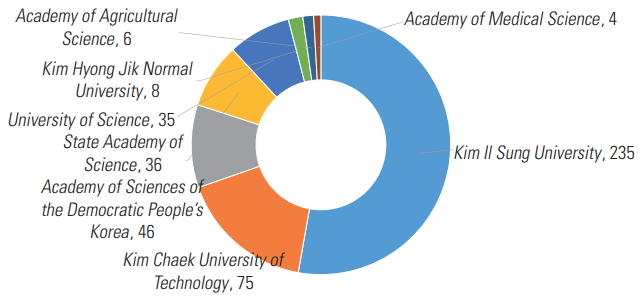
Top 12 organizations in North Korea from which researchers published articles in Web of Science journals from 1978 to July 2018 [cited on July 31, 2018].
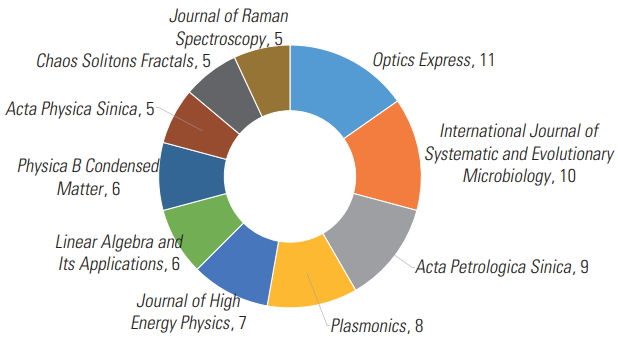
Top 8 journals that published the most articles by North Korean authors in the Web of Science Core Collection from 1978 to July 2018 [cited on July 31, 2018].
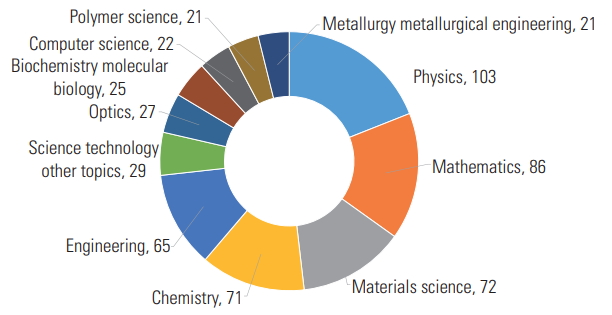
Top 11 research fields of North Korean authors’ works in the Web of Science Core Collection from 1978 to July 2018 categorized by the Web of Science [cited on July 31, 2018].
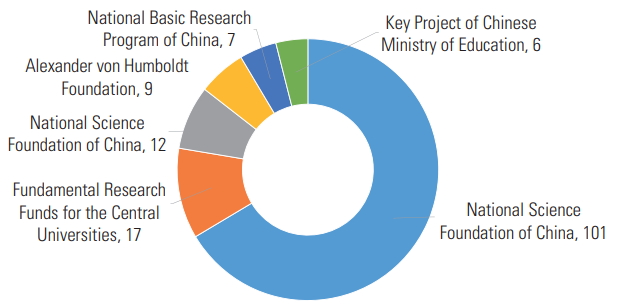
Top 6 funders of North Korean authors of articles from the Web of Science Core Collection [cited on July 31, 2018].
Of the 533 articles, 105 were written by North Korean authors only. The number of those articles began to increase in 2018 (Fig. 1, Suppl. 1). The affiliations of the authors of those articles were as follows: Kim Il Sung University (56), the Academy of Sciences of the Democratic People’s Republic of Korea (18), the State Academy of Science (11), Kim Chaek University of Technology (1), and University of Science (9) (Fig. 7, Suppl. 7). Four such articles were published in Journal of Materials Science and Plasmonics, respectively. The other source titles are listed in Suppl. 8.
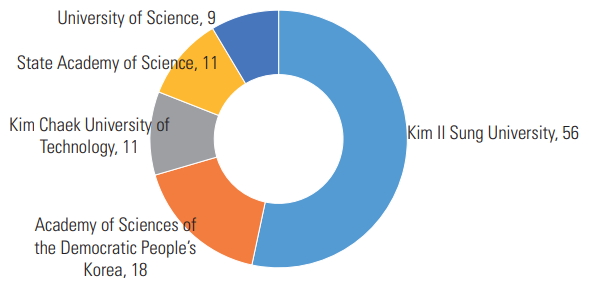
Top 5 organizations in North Korea from which researchers published articles in Web of Science journals without co-authors from other countries from 1978 to July 2018 [cited on July 31, 2018].
The major research fields of articles by North Korean authors only were physics (29), mathematics (24), material sciences (17), chemistry (14), and engineering (10) (Fig. 8, Suppl. 9). Those 105 articles were funded by 27 grants from 22 agencies, including 5 by the Ministry of Education of the Democratic People’s Republic of Korea and 4 by the State Committee of Science and Technology of the Democratic People’s Republic of Korea (Suppl. 10).
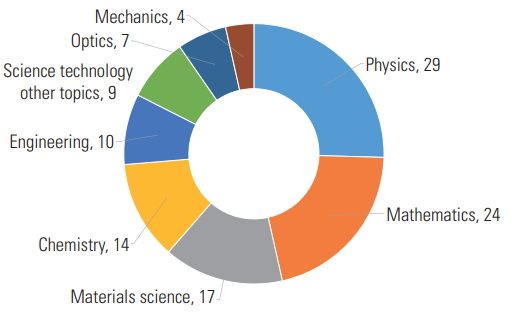
Top 8 ranking research fields of articles by only North Korean authors in the Web of Science Core Collection from 1978 to July 2018 categorized by the Web of Science [cited on July 31, 2018].
Word clouds are presented in Fig. 9. There were no significant differences between the corpus of all 533 articles and the corpus of the 105 articles by North Korean authors only (Fig. 9).
Discussion
The trend for an increasing number of articles by North Korean researchers to be published in Web of Science was the same as in the previous study, although the number of studies was greater than reported in the previous study. If the search year was limited to up to 2016, the total number of results was 381, or 63 articles more than reported in the previous study (318). Furthermore, the number of articles by North Korean authors only was 105, which is 59 more than reported in the previous study (46) (Fig. 1, Suppl. 1). Thus, the present results contain more accurate information.
China was the main collaborating country, as in the previous report, and 55.3% of all articles involved collaboration with Chinese researchers (Fig. 2, Suppl. 2). This result shows that a number of researchers from North Korea visited China to study and then maintained a continuous research relationship. In this study, South Korea was the ninth-ranked collaborating country, with only 6 works involving collaboration between North and South Korean researchers. This indicates that there were negligible opportunities for scientific collaboration between these 2 countries due to political tensions. The fact that the vast majority of the 533 articles involved international collaboration, with a total of 49 countries, indicates good international scientific relationships. Articles by North Korean researchers only accounted for 19.7% of the 533 articles, which indicates that many publications by North Korean researchers were supported by funding from other countries. The 533 articles we identified were supported by 605 grants from foreign countries. Thirteen grants were from North Korea (Suppls. 6, 10). In addition to the 5 top-ranking organizations in North Korea presented above (Fig. 3), Kim Hyong Jik Normal University, the Academy of Agricultural Science, and the Academy of Medical Science were major organizations that published articles by North Korean researchers only (Suppl. 10). Twenty-four South Korea institutions and 1 Chinese institution were included in the list of affiliations of articles published by North Korean researchers. This may have reflected typos in the articles. However, in this study, those articles were excluded, as in the previous report, where articles with erroneous listings of the country of researchers were likewise excluded.
In the previous report, the journals that published the most articles by North Korean researchers were International Journal of Systematic and Evolutionary Microbiology (8), Journal of High Energy Physics (7), Linear Algebra and Its Applications (6), Physica B Condensed Matter (5), Journal of Raman Spectroscopy (5), and Acta Physica Sinica (5). In this study, the most articles by North Korean researchers were found in Optics Express (11), International Journal of Systematic and Evolutionary Microbiology (10), Acta Petrologica Sinica (9), Plasmonics (8), and Journal of High Energy Physics (7) (Fig. 4). In the previous results, the main research fields were physics, mathematics, material sciences, chemistry, and engineering. In this report, the same results were found: physics, mathematics, material sciences, chemistry, and engineering (Fig. 5).
In this analysis, we analyzed the funding agencies. There were 605 grants that supported 533 articles. Thus, most articles were funded. In particular, there were a number of funding agencies in North Korea. The word clouds generated in this analysis were almost identical to those presented in the previous report (Fig. 9). This study also had some methodological differences with the previous report: first, the year of the search term extended to July 2018; and second, data from ESCI were included, although ESCI only accounted for 10 articles.
In conclusion, our results showed a greater number of publications in the Web of Science Core Collection from North Korea than was reported in our previous study. Almost identical results were found regarding the collaborating countries, journal titles, and research fields. It is also evident that there was a surge in the number of articles in 2015 and 2016. The trend for an increased number of publications from North Korea indicates that the North Korean government has asked researchers to publish their work in international journals, which means that elite researchers in North Korea can access the internet to submit their manuscripts to international journals without hindrance. We believe that all information published in free or open-access scholarly journals was available to them. We anticipate that there may be a further rapid increase in the number of articles from North Korea published in the Web of Science Core Collection.
Notes
No potential conflict of interest relevant to this article was reported.
Acknowledgements
This work was supported by Hallym University Research Fund (HRF-201610-011).
Supplementary Materials
Supplementary files are available from: https://doi.org/10.6087/kcse.135
Suppl. 1. Year of publication of 533 articles by North Korean authors from the Web of Science Core Collection [cited on July 31, 2018].
Suppl. 2. List of collaborating authors’ countries from 533 articles by North Korean authors from the Web of Science Core Collection [cited on July 31, 2018].
Suppl. 3. List of organizational affiliations from 533 articles by North Korean authors from the Web of Science Core Collection [cited on July 31, 2018].
Suppl. 4. Citation data, including authors, source journal titles, publication year, and abstract, of 533 articles by North Korean authors from the Web of Science Core Collection [cited on July 31, 2018].
Suppl. 5. List of research fields of 533 articles by North Korean authors from the Web of Science Core Collection [cited on July 31, 2018].
Suppl. 6. List of funding agencies acknowledged in articles by North Korean authors from the Web of Science Core Collection [cited on July 31, 2018]. Some funding agencies in South Korea were included; however, they were not major contributors.
Suppl. 7. List of organizational affiliations from 105 articles by North Korean authors only from the Web of Science Core Collection [cited on July 31, 2018].
Suppl. 8. Citation data, including authors, source journal titles, publication year, and abstract, of 105 articles by North Korean authors only from the Web of Science Core Collection [cited on July 31, 2018].
Suppl. 9. List of research fields of 105 articles by North Korean authors only from the Web of Science Core Collection [cited on July 31, 2018]. Some data from South Korea were included; however, they were not major contributors.
Suppl. 10. List of funding agencies acknowledged in 105 articles by North Korean authors only from the Web of Science Core Collection [cited on July 31, 2018].


